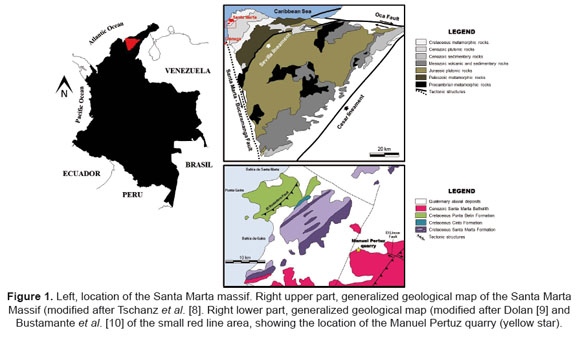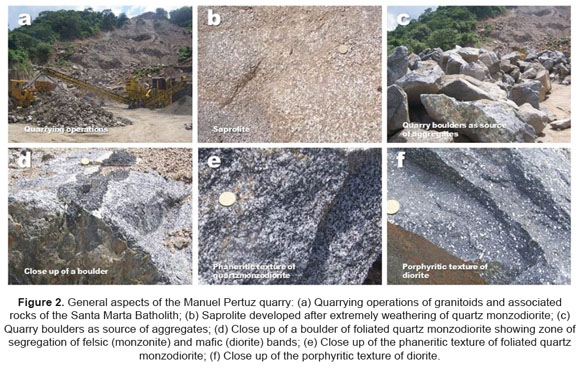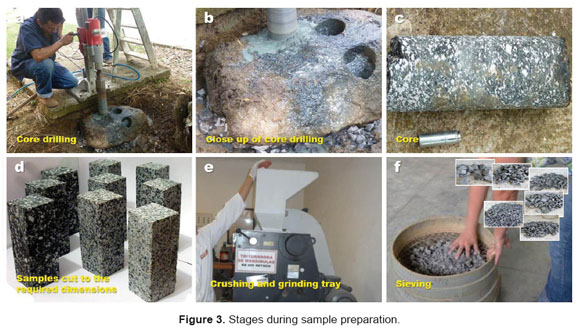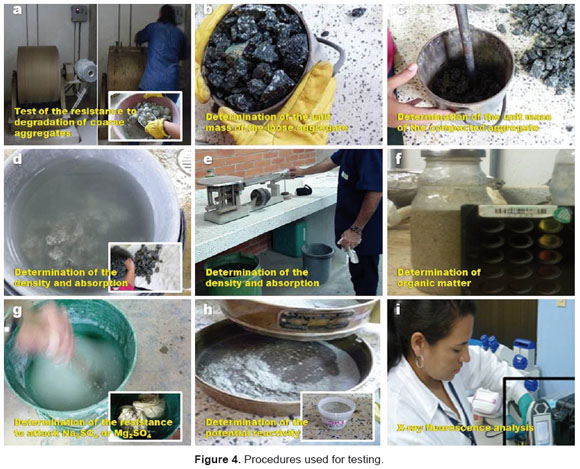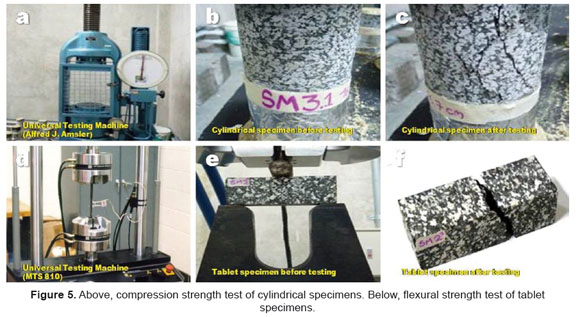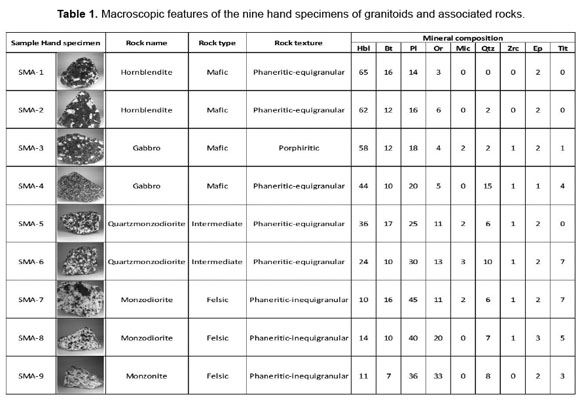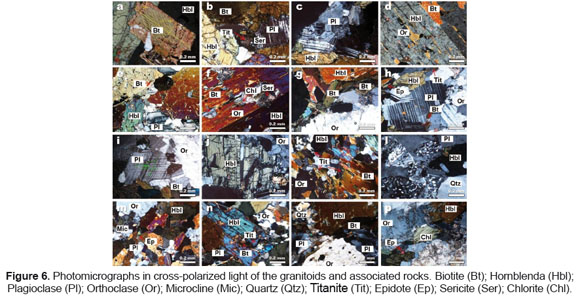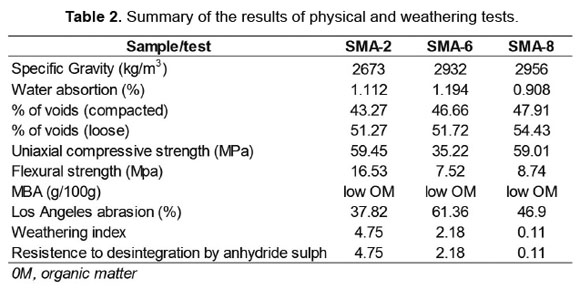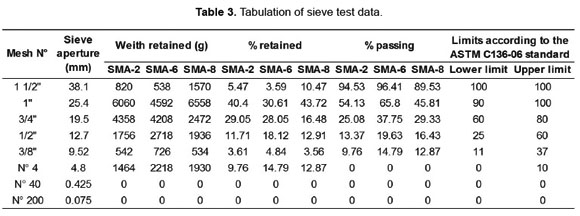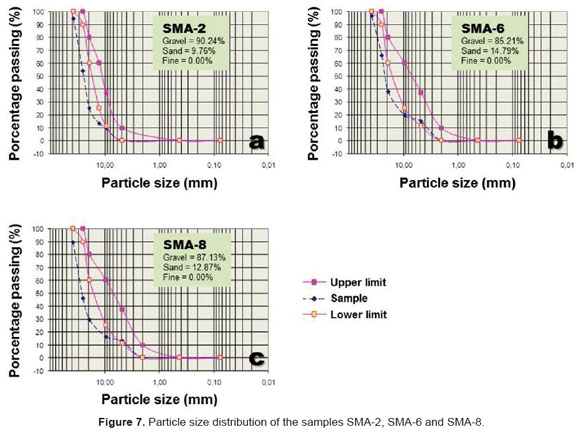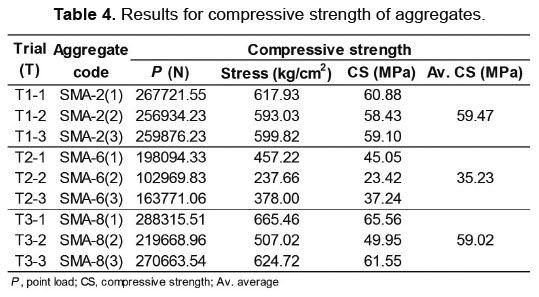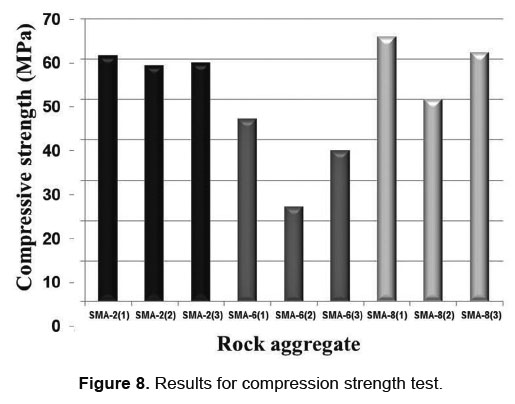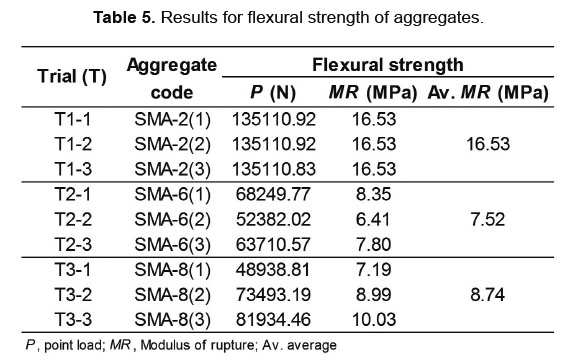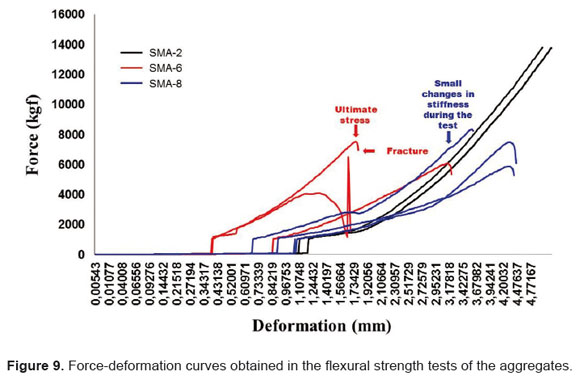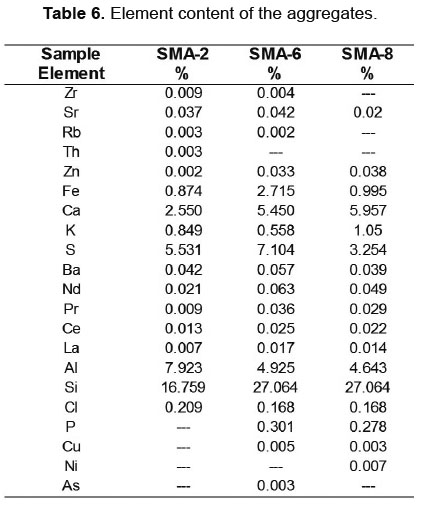Services on Demand
Journal
Article
Indicators
-
 Cited by SciELO
Cited by SciELO -
 Access statistics
Access statistics
Related links
-
 Cited by Google
Cited by Google -
 Similars in
SciELO
Similars in
SciELO -
 Similars in Google
Similars in Google
Share
Revista ION
Print version ISSN 0120-100X
Rev. ion vol.27 no.2 Bucaramanga July/Dec. 2014
of the Santa Marta Batholith, (Colombia)
Nancy Paola Figueroa Madero1; Sandra Paola Mendoza Ortíz1; Carlos Alberto Ríos Reyes1*;
Oscar Mauricio Castellanos Alarcón2
1 Escuela de Geología. Universidad Industrial de Santander, Cra. 27 Cl 9, Bucaramanga, Colombia
* carios@uis.edu.co
2 Programa de Geología. Universidad de Pamplona, Campus Villa del Rosario, Cl5 No. 2-38, Barrio Latino, Cúcuta, Colombia.
Fecha Recepción: 25 de febrero de 2014
Fecha Aceptación: 27 de septiembre de 2014
Aggregates of intrusive rocks are the major source of crushed fine and coarse aggregates for use in concrete in several countries and they have to meet a number of specifications relating to strength and durability. This research reports the evaluation of aggregates of granitoids and associated rocks of Santa Marta Batholith, Sierra Nevada de Santa Marta Massif, Colombia, based on petrographic analysis and mechanical and chemical acceptance tests. The strength and durability of a particular rock type depends on its intrinsic characteristic, thus petrographic analysis is very important to understand its mechanical and chemical properties. Numerous standard tests used to ensure aggregates meet the appropriate specifications; however, petrographic analysis represents the most valuable test for predicting the overall performance of concrete aggregates in any control test. Aggregates were analyzed to determine their petrographic, physical, mechanical and chemical properties. Samples were categorized as hornblendite, gabbro, quartzmonzodiorite, monzodiorite and monzonite groups. Among these, of the quartzmonzodiorite was the dominant group. Specific gravity indicates values in the range 2673-2956kg/m3. Water absorption values are in the range 0.908-1.194%. Aggregate impact values of samples (37.82 to 61.36%) showed good soundness only for one of the aggregates, which are considered acceptable for use in the preparation of a good quality concrete. Values of Methylene Blue Adsorption reveal the organic matter content is below the threshold. Magnesium sulphate values ranged between 0.11 and 4.75% suggesting good resistance against chemical atmospheric agents. The compressive strength test shows values in the range 35.22-59.45MPa indicating that the geomechanical behavior of rock cylinders is satisfactory. The geomechanical behavior of rock tablets under flexion is also satisfactory for SMA-2 sample (16.53MPa), although not for SMA-6 and SMA-8 samples, which showed values of 7.52 and 8.74MPa, respectively. Comparing with the existing American Standard of Testing Material, the studied samples are suitable for concrete.
Keywords: aggregates, granitoids and associated rocks, petrographic analysis, mechanical and chemical properties, strength and durability, concrete.
del Batolito de Santa Marta, (Colombia)
Los agregados de rocas intrusivas son la principal fuente de triturado de agregados finos y gruesos para uso en concreto en varios países, los cuales tienen que cumplir una serie de especificaciones con relación a resistencia y durabilidad. Esta investigación presenta la evaluación de agregados de granitoides y rocas asociadas del Batolito de Santa Marta, Macizo Sierra Nevada de Santa Marta, Colombia, con base en el análisis petrográfico y ensayos de resistencia mecánica y química. La resistencia y durabilidad de cualquier tipo de roca depende de su característica intrínseca, de esta manera el análisis petrográfico es muy importante para entender sus propiedades mecánicas y químicas. Numerosas pruebas estándar se utilizan para determinar si los agregados cumplen las especificaciones apropiadas, sin embargo, el análisis petrográfico representa la prueba más valiosa para predecir el rendimiento global del hormigón en cualquier prueba de control. Los agregados se analizaron para determinar sus características petrográficas, y propiedades físicas, mecánicas y químicas. Las muestras se clasificaron como hornblendita, gabro, cuarzomonzodiorita, monzodiorita y monzonita, siendo la cuarzomonzodiorita el grupo dominante. El peso específico indica valores en el rango de 2673-2956kg/m3. Los valores de absorción de agua están en el intervalo 0,908-1,194%. Los valores agregados de impacto de las muestras (37,82 a 61,36%) mostraron buena solidez sólo para uno de los agregados, lo cual se considera aceptable para su uso en la preparación de hormigón de buena calidad. Los valores de absorción de azul de metileno revelan que el contenido de materia orgánica es inferior al umbral. Los valores de sulfato de magnesio oscilan entre 0,11% y 4,75% lo que sugiere una buena resistencia a los agentes atmosféricos químicos. La prueba de resistencia a la compresión muestra valores en el rango de 35,22-59,45MPa, por lo tanto, el comportamiento geomecánico de cilindros de roca fue satisfactorio. El comportamiento geomecánico de tabletas de roca bajo flexión fue también satisfactorio para la muestra SMA-2 (16,53MPa), aunque no para las muestras SMA-6 y SMA-8, que mostraron valores de 7,52 y 8,74MPa, respectivamente. En comparación con la actual Norma Americana de Ensayos de Materiales, las muestras estudiadas son adecuadas para el hormigón.
Palabras clave: agregados, granitoides y rocas asociadas, análisis petrográfico, las propiedades mecánicas y químicas, resistencia y durabilidad, hormigón.
do Batólito de Santa Marta, (Colombia)
Os agregados de rochas intrusivas são a principal fonte de britagem e grossos finos para uso em concreto em vários países, que têm de cumprir determinadas especificações relativas à resistência e durabilidade. Esta pesquisa apresenta a avaliação de agregados e rochas graníticas associadas do batólito Santa Marta, Sierra Nevada Maciço de Santa Marta, Colômbia, com base na análise petrográfica, e testes de resistência mecânica e química. A resistência e durabilidade de qualquer tipo de rocha depende da sua característica inerente, de modo que a análise petrográfica é muito importante para compreender as suas propriedades físicas e químicas. Vários testes padrão foram utilizados para determinar se os agregados satisfazer as especificações apropriadas, no entanto, a análise petrographic representa o teste mais valioso para prever o desempenho global do betão em qualquer teste de controlo. As amostras globais foram analisadas quanto às características petrográficas e propriedades físicas, mecânicas e químicas. As amostras foram classificadas como hornblendite, gabro, cuarzomonzodiorita, monzodiorita e monzonite cuarzomonzodiorita sendo o grupo dominante. Os valores dos pesos específicos indicados na gama 2673- 2956kg/m3. Os valores de absorção de água estão na gama de 0,908-1,194%. Os valores de impacto de Agregados as amostras (37,82-61,36%) mostrou uma boa solidez a apenas um dos agregados, o que é considerado aceitável para utilização na preparação de uma boa qualidade do betão. A absorção de valores de metileno azul mostra que o material orgânico é inferior ao limiar. Os valores de sulfato de magnésio situam-se entre 0,11% e 4,75%, sugerindo uma boa resistência ao desgaste químico. Os valores de resistência à compressão de amostras de teste na gama de 35,22-59,45MPa, por conseguinte, o comportamento de cilindros geomecânica rocha foi satisfatória. O comportamento geomecânico de rocha sob tablets dobra também foi satisfatória para a SMA-2 da amostra (16,53MPa), mas não para os SMA-6 SMA-8 amostras que apresentaram valores de 7,52 e 8,74MPa, respectivamente. Em comparação com os atuais americanos Materiais padrão de teste, as amostras estudadas são adequadas para concreto.
Palabras-chave: agregados, granitóides e rochas associadas, análise petrográfica, propriedades mecânicas e químicas, resistência e durabilidade, concreto.
Cita: Figueroa Madero NP, Mendoza Ortíz SP, Ríos Reyes CA, Castellanos Alarcón OM. Characterization and testing of rock aggregates of the Santa Marta Batholith, (Colombia). rev.ion. 2014;27(2):87-104.
Rock aggregates are granular materials which are used as raw material in the construction industry and play a major role in road and railroad construction and the manufacture of asphalt and concrete. The availability of high quality, low cost, environmentally friendly rock aggregates and recirculation of materials is important for the development of a sustainable society [1]. However, this does not ensure widespread availability with the specific requirements, which are always met by the available material. Therefore, it is important to have the appropriate skills to determine which material is suitable for use as rock aggregates. More than 75 million tons of rock aggregates are produced in Colombia. Most civil engineering works in Colombia use the concrete as a fundamental construction material. To produce a good structural concrete is necessary a good quality of aggregates. Since up to 80% of the total volume of concrete consists of aggregates, their characteristics significantly affect the performance of fresh and hardened concrete and have an impact on the cost effectiveness of concrete [2]. According to Carino [3], the concrete is defined as a composite consisting of a binding medium into which are embedded particles or fragments of aggregates. It uses a hydraulic cement, water and crushed sand [4]. With respect to coarse aggregate, concrete can be prepared with aggregates of 5mm in average size, having strengths higher than that prepared with aggregates of 10mm in average size, for the same water/cement ratio [5]. The shape, texture and angularity among other characteristics of the stone have special effect on the strength and durability of concrete [6,7]. The main objective of this study is to investigate the geomechanical properties of rocks mined to obtain aggregates for concrete at the Manuel Pertuz quarry, Santa Marta (Magdalena), Colombia.
Geological setting
The Manuel Pertuz quarry is located on the southeast of Santa Marta (Magdalena), Colombia, around Bureche, geographical coordinates are: 11°11'22.35"N, 74°11'06.98"W and 52m. It forms part of the Santa Marta massif, which constitutes an isolated triangular-shaped range on the northern Caribbean region of Colombia (Figure 1), limited by the Oca fault, the Santa Marta-Bucaramanga fault and the Cesar lineament as its main tectonic boundaries. This massif is formed of predominantly crystalline rocks and can be divided into three different belts (geotectonic provinces) with a well-defined outboard younging pattern from east to west are: Sierra Nevada, Sevilla and Santa Marta. The northwestern and youngest belt (Santa Marta province) comprises two metamorphic belts; an inner belt composed by imbricated metamorphic rocks (greenschists and amphibolites) of Cretaceous age and an outer belt composed by Mesozoic amphibolites, greenschists and phyllites separated by the lower to middle Cenozoic Santa Marta Batholith [8].
Figure 2a shows the operations at the Manuel Pertuz quarry, which does not show major tectonic features, however, a dextral strike-slip fault (El Limón Fault) and a reverse fault occurs to the southeast part. Outcrops show several joint systems and rocks display a foliated structure due to mechanical and chemical weathering. Figure 2b illustrates a well compacted sandy granular saprolite as a result of "in situ" weathering of an intrusive rock of quartz monzodiorite composition according to the classification of Streckeisen [11]. The observed reddish brown coloration is due to oxidation of ferromagnesian minerals. The formation of this saprolite was controlled by three variables: (1) parental rock composition - quartz monzodiorite, mainly composed of quartz, biotite, hornblende and plagioclase; (2) environmental conditions - tropical climate, with rainfall ranging between 500 and 1000mm and hills with steep to moderate slopes; (3) time - the exposed rocks are of Paleogene age. Extraction (more commonly referred to as quarrying) consists of removing blocks or boulders (Figure 2c) of granitoids and associated rocks belonging to the NE-SW Santa Marta Batholith. The extraction process is done by blasting, while an excavator is responsible for booting the blasted rocks, depositing them in the front of exploitation. Then, dump trucks move them to the log yard, where workers break the larger blocks of rocks (boulders) to obtain appropriate sizes which are then transported to several crushers where is possible to obtain crushed stones of several sizes. Figure 2d shows a boulder of foliated quartz monzodiorite showing zone of segregation of felsic and mafic bands. A phaneritic texture of foliated quartz monzodiorite with a speckled appearance due to the presence of hornblende and biotite in a quartzfeldespatic matrix is illustrated in Figure 2e, whereas a porphyritic texture of diorite is illustrated in Figure 2f. Quarrying involves not only extraction of material (rock) but also crushing and screening that makes the rock suitable for use as construction material.
In general, the quarry rocks are frequently weathered near the surface developing a saprolite, which is the result of a combination of two processes: (1) mechanical weathering and (2) chemical weathering. The mechanical weathering makes the rock loses its coherence, but has little effect upon the change in the composition of the rock material, which can be reflected by opening up of joints or grain boundaries, and cleavage of individual mineral grains, whereas the chemical weathering involves rock decay accompanied by marked changes in chemical and mineralogical composition and is reflected by color change of the rock, transformation of silicate minerals. In the weathering process, there is a universal tendency for rounded surfaces to form on a decaying rock body regardless of the original shapes of the rock fragments, developing spheroidal weathering (the edges and corners of a joint block are easily decomposed), which is locally observed in the saprolite.
Fieldwork sampling
The fieldwork included a technique visit to carry out the recognition of the front of exploitation, taking into account the occurrence of granitoids and associated rocks with different mineral composition and textural and structural features. Additional geological information was obtained in order to know the existing types of rock aggregates at the quarry, mining techniques, material production, application in the construction industry, etc. Nine hand-specimen samples ranging from felsic to mafic composition were collected from blocks previously extracted to prepare thin sections. On the other hand, three samples (blocks of rock) of approximately 50cm x 40cm x 30cm were collected in order to have enough material to perform testing. Samples for preliminary investigation tests were obtained according to the standard ASTM D75/ D75M-09 [12].
Sample preparation
Sample preparation followed the ASTM standards (Figure 3). The processes involved in this phase are: drilling of cores, cutting of tablets, crushing, sieving and preparation of thin sections. Drill cores were obtained with a rock coring equipment (Figures 3a-3c) for the compressive strength test of concrete cylindrical specimens following the standard ASTM D4543-08 [13]. All material remaining after drilling was used to obtain tablets of 5cm x 5cm x 12cm (Figure 3d) according to the standard ASTM C78/ C78M-10 [14], using a Buehler (Delta Petrocut model) geological cutter. The remaining material after drilling and cutting was processed by crushing, which was carried out in a Retsch Jaw Crusher BB200 to ~3.8 cm (Figure 3e). The sieving (Figure 3f) of granular materials was carried out according to the standard ASTM C136-06 [15] in a Ro-Tap sieve shaker (using 1 ½, 1, ¾, ½, 3/8 and 4 mesh series). Thin section preparation was performed in a Petro-Thin sectioning system and a Buehler (Metaserv 2000 model) polishing machine.
Petrographic characterization and determination of oxides and microfractures
Petrographic analyses were done to evaluate the mineralogical composition, texture, pore structure, opaque and secondary mineral content and weathering rate of the granitoids and associated rocks. Determination of oxides and microfractures in thin section was performed according to the standard ASTM C295/C295M-12 [16].
Testing
Procedures used for testing are in accordance with national and international standards. Other methods or criteria developed during the present work are described below. The following standards were used during testing (Figure 4): ASTMC535-12 [17] for degradation resistance of large size coarse aggregate by abrasion and impact in Los Angeles Machine (Figure 4a), ASTM C29/C29M-09 [18] for bulk density and voids in aggregate (Figures 4b-4c), ASTM C127-12 [19] for density, relative density, and absorption of coarse aggregate (Figures 4d-4e), ASTM C40/C40M-11 [20] for organic impurities in fine aggregates for concrete (Figure 4f), using an Orbeco-Hellige 815 Tester was used for quick and accurate tests of organic matter, ASTM C88-05 [21] for soundness of aggregates by use of sodium sulfate or magnesium sulfate (Figure 4g), ASTM C289-07 [22] for potential alkali silica reactivity of aggregates (Figure 4h). Moreover, quantitative identification of elements was determined by X-ray fluorescence (Figure 4i), using a portable spectrometer (Niton XL3t with X-ray tube of 50kV and 100μA with the option of incorporating a silver anode for analysis of light elements.
The typical load and compressive and flexural strength tests are shown in Figure 5. A Universal Testing Machine (Alfred J. Amsler) with a maximum load of up to 5tons was used in the compressive strength tests, following the standard ASTM C39/ C39M-12 [23]. All specimens were subjected to a compressive load at a crosshead speed of 0.5mm/min. The test of compressive strength, where compressive stresses were applied to each specimen, was conducted to determine the level of deformation of the material. A Universal Testing Machine (MTS 810) with a maximum load of 500,000N was used in the flexural strength tests, following the standard ASTM C78/C78M-10 [24], taking into account its accuracy (0.01), flexibility, high performance, and innovative standard features; large test space to accommodate standard, medium and large size specimens, grips, fixtures and environmental subsystem, and environmental chamber dimension: 500 x 255 x 350mm. Data were recorded automatically to the computer system. The three-point bending flexural strength test were conducted with a crosshead speed of 0.2mm/s and a distance between the supports of 90mm. The test provides values for the modulus of rupture (MR) of the specimens. MR can be calculated using the following equation:

Where MR is the flexural modulus of rupture (MPa), P is the maximum applied load (N), a is the distance between line of fracture and the nearest support (mm), b and d are the width and thickness of the specimen (mm), respectively.
Figueroa & Mendoza [25] described in detail these tests. The determination of the quality of the stone aggregates considered both petrographic characteristics and physical, mechanical and chemical properties. The stone aggregates have been used as natural building materials, therefore, they require an adequate quality control. Three coarse aggregates were used in this study. Aggregates were selected to represent various types of mineralogy and to exhibit different shape characteristics, based on preliminary visual inspection, which was conducted to verify that these aggregates represent different characteristics. At this point, the coarse aggregate fraction was replaced of the original mixture design essentially keeping the same gradation in order to produce several mixture designs. Concrete is a heterogeneous mixture of cement, water, fine and coarse aggregates, with coarse aggregates representing about 75% of the volume of concrete and therefore have a major influence on the properties of concrete. According to Mukhopadhyay et al. [26], the roles of physical, mechanical, and chemical properties of coarse aggregates on the behavior and performance of concrete are often described in terms of their effects on concrete strength, shrinkage, creep, and bond strength; the physical attributes relate to concrete mixing, placing, finishing, hardening, and other construction and pavement related characteristics; the mechanical properties of an aggregate predict its ability to resist loads and stresses, hardened concrete behavior; the chemical properties of an aggregate are a result of its chemical composition and are related to how the aggregate chemically interacts with concrete pore solution and water.
Petrography analysis
Aggregates used in this study correspond to igneous rocks, which tend to be massive rocks of generally high strength and do not show problems in construction when they are fresh. Their constituent minerals are of a dense interfingering nature resulting in only slight, if any, directional differences in mechanical properties of the rock. The petrographic analysis reveals not only important structural and textural features of the analyzed rocks but also the mineral composition and type of mineral phases of them. Table 1 summarizes the main petrographic features observed at macroscopic scale in the analyzed samples. The main rock-forming minerals identified in the aggregates correspond to biotite, hornblende, biotite, plagioclase, orthoclase, microcline, quartz, titanite and epidote, with sericite and chlorite as the main secondary minerals, and the aggregates are of hornblendite, gabbro, quartzmonzodiorite, monzodiorite and monzonite composition. The mineralogy of these rocks is very important because SiO2 can be attributed not only to feldspars and quartz but also to ferromagnesian silicates (e.g., hornblende and biotite), which are essential mineral phases in these rocks, and they also contain SiO2. Calcite and dolomite are not present in these rocks as a primary crystallizing phase. Therefore, allotment of CaO to calcite and dolomite is not valid for these groups of rocks where its primary source is plagioclase, hornblende, epidote and titanite.
Microscopic analyses in this study did not reveal a strong heterogeneity of the contact nature between the mineral phases in each sample. According to Hussin & Poole [27], although this method is qualitatively based, it is possible to predict the mechanical behavior of aggregates. Texture parameters such as the degree of grain interlocking and mineral contact plays an important role in the mechanical properties [28]. As reported by Hussin & Poole [27], a decrease in grain size causes a slight decrease in the impact value of the aggregates. However, the analyzed aggregates are mainly composed of equidimensional crystals, which suggests that the resistance of the aggregates to the effect of impact is not strongly affected by grain size. This is very important, taking into account that different petrographic properties such as grain size, mineral dispersion and texture affect the mechanical properties of aggregates [27].
Figure 6 summarizes the main petrographic features at microscopic scale observed in the analyzed samples, which were classified according to Streckeisen [11]. Figure 6a illustrates a biotite crystal showing basal cleavage and anhedral quartz inclusions. Hornblende also occurs in the left and right part, the last one displaying a nearly extinction position. In Figure 6b is observed an intermediate plagioclase with characteristic twinning and alteration to sericite. It occurs along with hornblende showing characteristic birefringence, nearly extincted biotite and titanite. A typical association of polysynthetic plagioclase and hornblende is observed in Figure 6c. Hornblende is being replaced by biotite along its cleavage. It shows small inclusions of orthoclase (Figure 6d). A mineral association consisting of plagioclase with albite-type twinning, hornblende and biotite is illustrated in Figure 6e. A large crystal of hornblende with Carlsbad twinning showing biotite and plagioclase inclusions is observed in Figure 6f. Biotite and plagioclase are altered to chlorite and sericite, respectively. Figure 6g shows the occurrence of orthoclase along with biotite and hornblende. In Figure 6h is illustrated a large crystal of plagioclase with albite-type twinning, surrounded by orthoclase, hornblende with typical shape and cleavage, as well as small crystals of accessory epidote and titanite. Plagioclase with two types of twins in the same crystal is observed in Figure 6i. Other mineral phases, such as orthoclase, hornblende and biotite also occur. Hornblende displaying typical one direction cleavage is observed in Figure 6j. It occurs along with orthoclase, biotite and accessory titanite. Biotite with accessory titanite along with hornblende and orthoclase are observed in Figure 6k. A myrmekitic texture, which describes a vermicular intergrowth of quartz in plagioclase, is illustrated in Figure 6l. Epidote occurs as an accessory phase along with hornblende, biotite, plagioclase, orthoclase and microcline, the last of them without displaying the characteristic "tartan" twinning (Figure 6m). Figure 6n shows hornblende with bluish-green birefringence and orthoclase with undulating extinction. Plagioclase and accessory titanite are also observed. Figure 6o illustrates quartz showing irregular shape and wavy extinction. Biotite penetrated by deformed plagioclase, as well as orthoclase and hornblende also occur. Figure 6p illustrates chloritized and highly fractured hornblende. Orthoclase shows intense alteration to kaolinite. Epidote occurs as an accessory phase.
The physical properties of coarse aggregates are also associated with the rock weathering state [29]. Alteration mechanisms lead to internal breaking that promotes weathering and material loss due to dissolution or internal erosion. Minor alterations were found in the tested aggregates, which correspond to incipient alteration of plagioclase to sericite, potassium feldspar to kaolinite and biotite or hornblende to chlorite. The process of rock weathering, which is revealed by the formation of these alteration minerals, has great influence on engineering behavior of rock aggregates. According to Kazi & Al-Mansour [30], as well as those characteristics which indicate rock alteration, there are others, which indirectly are a consequence of the first ones such as density, mechanical resistance and permeability.
The determination of oxides and microfractures in thin section showed generally that oxides are present in the samples with iron oxides such as magnetite and hematite. Magnetite is characterized by a bluish black colored under reflected light microscopy, while hematite displayed a red color. The hematite develops halos of oxidation around the magnetite. The content of oxides (magnetite and hematite) is variable, and, in general, all samples containing such minerals in trace amounts, except sample SMA-1, which presents 3-5% of iron oxides. Pyrite (a sulfide phase) occurs in most cases in association with magnetite and hematite. From a petrographic point of view, these rocks shows a massive appearance with very low to almost absent microfractures, however, samples SMA-7, SMA-8 and SMA-9, display brittle deformation processes, as revealed by some microfractures filled by pyrite.
Testing
Results from testing according to Colombian standards for samples SMA-2, SMA-6 and SMA-8 are described below and summarized in Table 2. The number and series of specimens was according to ASTM standards.
Granulometry. Table 3 depicts the percentages of passing each test sieve particle size of the samples. The particle size distribution of the aggregates was obtained by sieve analyses [15]. Aggregates are mainly composed of gravel (87.13-90.24%) particles, with 9.76-14.79% of fine particles and no fine (0%) particles.
The data are represented in the granulometric curves of Figure 7. The granulometric distribution of the material are not within the limits set by the standard ASTM C136-06 [15], indicating that the material has not an suitable graduation, which is to during the crushing process a random size was not specified, that is a specific measure was taken, therefore, this property can be controlled and modified to meet the standards to satisfy the standard.
Resistance to Degradation of Large Size Coarse Aggregate by Abrasion and Impact in Los Angeles Machine. The purpose of this test was to determine the degradation that befalls in graded aggregates under the effect of friction and percussion forces. A representative quantity of material for each sample was sieved and according to the retained percentages on each sieve the type of degradation was carried out. It is commonly thought that the mineral content is of great importance for the degree of fragmentation and abrasion. Mineral composition, grain size, grain shape, grain spatial arrangement, porosity, crack, etc. have an effect the resistance of agregates to fragmentation and abrasion [1].
Table 2 shows the degradation rates, with abrasion values range between 37.82% and 61.36%. Results reveal that the maximum abrasion was observed for the SMA-6 sample and the minimum abrasion was observed for the SMA-2 sample. According to these results, only the SMA-2 sample is considered acceptable for use in the preparation of a good quality concrete, whereas SMA-6 and SMA-8 samples do not enter within the limits set by the standard ASTM C535-12 [15]. The variation in amphibole is an important factor affecting the mechanical parameters, and, therefore, the strength reduction of the aggregates is a function of an increase in amphibole content. However, the variation in feldspar content has a greater effect on the impact value than on the abrasion value, which is probably a consequence of the relatively weak bonding along the cleavage planes in feldspars which presumably has a greater negative effect upon the brittleness of the rock than on the abrasion resistance [1]. It was found that the resistance to degradation of the aggregates increases when rising content of quartz and feldspar. On the other hand, because mica is a soft mineral, it is likely that an increase in the content will have a stronger negative effect upon the abrasion resistance than on the brittleness of the rock.
Density (Unit Weight). Table 2 shows that the SMA- 2 (43.27% of voids (compacted)) sample set range (between 30 and 45%) established by the standard ASTM C29/C29M-09 [18], while SMA-6 (46.66%) and SMA-8 (47.91%) samples are not within this acceptance range. Regarding percentage of voids (loose), all samples are above the reference limit. Samples not meeting these specifications would modify the concrete properties thereby reducing its mechanical properties quite. It is possible that the particle size distribution curve is affecting the obtained values as the size of the particles has a uniform trend.
Density, Relative Density (Specific Gravity), and Absorption. Density, specific gravity and absorption values are depicted in Table 2. The specific gravity for coarse aggregates according to the standard ASTM C127-12 [19] indicates that the most usual values of natural aggregates are between 2400 and 2900kg/m3. This study reports values of 2673kg/m3 (sample SMA-2), within the range of normal aggregate particles, and 2932kg/m3 (sample SMA-6) and 2956kg/m3 (sample SMA-8), within the range of heavy aggregate particles. The lowest density displayed by sample SMA-2 reflects its less dense nature. It is possible to consider the aggregates in this study as low porosity rocks, but the sample SMA-2 exhibits a significant porosity value. This characteristic is unique to each material, therefore, it should be excluded from the specifications for use in concrete mixtures. Consequently, it also should have the highest water absorption percentage. Water absorption values are in the range 0.908-1.194%.
Compressive strength of cylindrical specimens. It is the value of uniaxial compressive stress reached when the material fails completely. The compressive strength test determines the relationship stress vs strain of the testing samples. Representative set of the experimental test to determine the compressive strength of the testing samples and results are depicted in Table 4.
The geomechanical behavior of the rock cylinders (44.18cm2) subjected to the compression strength test is satisfactory (59.47MPa for SMA-2; 35.23MPa for SMA-6; 59.02MPa for SMA-8). The results of the compression strength test are illustrated in Figure 8. The ASTM specifications stipulate that the minimum compressive strength required for granite in building is 9.03MPa. Data obtained in this study do not correspond with data reported by Lozano and Romero [31] for the Pescadero Granite (131.0MPa) using rock cylinders of 25cm2. However, it is very important to consider that it was used twice the area of the specimens studied for the Pescadero Granite, and the compressive strength is inversely proportional to the area of the specimen. According to the ASTM specifications, the compression strength of the samples tested is located within the high range. However, the classification of rocks by compressive strength of Deere and Miller [32], located SMA-2 and SMA-8 samples within the class C with a medium compressive strength, and SMA-6 sample within the class D with a low compressive strength.
Flexural strength. It is the ability of a masonry brick, beam or slab to resist failure in bending. The values for the modulus of rupture (MR) are depicted in Table 5.
Figure 9 summarizes force vs deformation data, showing the geomechanical behavior of the rock tablets (12cm x 5cm x 5cm) under three-point flexion test. In general, the force-deformation curves for aggregates did not show a heterogeneous behavior under the same condition, and showed a few fracture points between the initial compression and deformation at maximum force. SMA-2 sample required more force to break than that obtained for SMA-6 and SMA-8 samples. Failure load was the peak load recorded before failure. It is satisfactory for SMA-2 sample (16.53 MPa) since data revealed that this sample exceed the value of 10.05MPa required for floors. SMA-6 and SMA-8 samples showed values of 7.52 and 8.74MPa, respectively, which are below this limit. However, the values obtained in this study are lower than those obtained by Lozano and Romero [31] for the Pescadero Granite (32.2MPa) using rock tablets of 25cm x 2.18cm x 1.746cm. The specifications of the standard ASTM-C78/C78M-10 [24] establish that the required minimum modulus of rupture for granite is used for construction is 10.24MPa, using rock tablets of 30cm x 7cm x 7cm.
Methylene blue adsorption test. The results of the methylene blue adsorption test, expressed in values of Methylene Blue Adsorption (MBA), reveal that all samples showed the lighter color, which indicates that the organic matter content is below the threshold, and, therefore, the rock aggregates are acceptable. Organic matter is considered harmful in coarse aggregates and it is necessary to know its content, because it affects cement hydration and if present in high levels, can lower concrete strength.
Soundness of Aggregates by Use of Sodium Sulfate or Magnesium Sulfate. Referring to the salinity of the coarse aggregates to determine the resistance to disintegration by the action of an anhydride sulphate solution at 24% purity in five cycles, a disintegration referred to graduation of 4.75, 2.18 and 0.11% (Table 2) occurred, being within the limits of the standard ASTM C88-05 [21], which sets a limit of 12%, defining thus a good quality of the aggregate that will be subjected to the action of atmospheric agents, so that at least for this coarse aggregate size, it is advisable to use in structures subject to abrasion, such as pavements.
Potential alkali silica reactivity of aggregates. The alkali-silica reaction is a reaction which occurs over time in concrete between the highly alkaline cement paste and reactive non-crystalline (amorphous) silica, which is found in many common aggregates [33]. The physical properties and proportion of deleterious materials which bear potential reactivity with the cement are crucial in any project concerning durability of structures, and the proportion of deleterious constituents are influenced by composition of constituent rock types in aggregates and degree of weathering of the constituents [34]. In many instances, petrographic results support for decision made on requirement of further chemical tests, and on aggregate selection [35].
The results of the test for the determination of silica by the gravimetric method are: 84.8% (SMA-2), 8.3% (SMA-6) and 77.2% (SMA-8), which are not high potential condition of reaction with alkaline cement. Therefore, it is necessary to complete the second phase of the standard ASTM C289-07 [20]. After petrographic analysis of each sample, the following mineral phases were identified: hornblende, biotite, plagioclase, quartz, orthoclase, microcline, epidote, titanite, zircon and clinozoisite. These mineral phases are found in the group of silicates, and, therefore, their mineral chemistry indicates a high percentage of silica (SiO2). It should be noted that to obtain a high reaction with alkalis of the cement it is necessary the presence of microcrystalline quartz and alkali feldspar (microcline, orthoclase and plagioclase of albite type) which provide the silica and alkali for reaction. These minerals were determined in all samples in substantial percentages. On the other hand, there is evidence of deformation. As stated above that these minerals are potentially reactive. Some harmful and alkali-silica reactive constituents are chalcedony, chert, microquartz, opal, high-T silica, cristobalite and tridymite, etc. Ríos et al. [36], using X-ray diffraction analysis concluded that silica is represented by low-quartz, and reactive silica (amorphous silica and quartz high) was not determined. There is no single pattern indicating intense curve matched with opal (amorphous silica; reactive silica). According to them, there is no other reactive high-quartz in the sample as silica scanning does not reveal such. Reactive silica is therefore absent from the rock categories. Therefore, percentages of constituent minerals indicate that the rock can safely be used as an aggregate with ordinary Portland cement and high alkali cement. However, mineral phases such as calcite and mica (chlorite and muscovite of sericite variety) also occur, which can promote the development of alkali-silicate and alkali-carbonate, respectively.
X-ray fluorescence. Table 6 shows the elemental composition of the aggregates obtained by X-ray fluorescence. All samples showed elemental affinity, which is evident for rocks from the same intrusive body. The greatest differences area observed in the SMA-6 sample, which contains 30% Si, exceeding 7-10% values obtained for the other samples, which means a higher content of silicate minerals. The percentage values of Fe and S are slightly higher, which supports the presence of pyrite in the sample. Given petrographic estimates, this sample contains biotite obviously rusty and a higher content of pyrite as filling microfractures or disseminated at lesser extent.
Based on the quality assessment of construction aggregates from the "Manuel Pertuz" quarry, the following conclusions can be drawn:
The study shows that data obtained from physical characterization and weathering, compressive and flexion strength and Los Angeles abrasion tests of rock aggregates do not provide enough information to estimate aggregate quality.
Although the petrographic characteristics of the studied samples maybe similar, each sample shows different quality behavior. Rock aggregates were categorized as hornblendite, gabbro, quartzmonzodiorite, monzodiorite and monzonite groups, according to the classification of Streckeisen [11]. Among these, samples of quartzmonzodiorite group were found dominant.
The classification of rock aggregates is not enough to judge their competence from the point of view of engineering, as some later geological processes have greater influence on their behavior. However, its composition and properties are reflected decisively in the characteristics of the concrete prepared from these.
Rock aggregates showed acceptable specific gravity and water absorption values, as well as impact values for use in the preparation of a good quality concrete.
The compression and flexion test show that aggregates classified by its high resistance to applied stresses that can cause deformation and fractures in the rocks, which is influenced by mineralogical, textural and structural characteristics.
Values of Methylene Blue Adsorption reveal the organic matter content is below the threshold, and, therefore, the rock aggregates are acceptable.
Aggregates resistance to sulfate attack anhydride satisfactorily meets the limit stipulated, and therefore they are very resistant to weathering.
The alkali-silica reactivity of aggregates is a critical parameter with regard to the concrete durability, and which affects its structural weakening and shortens its useful life. Petrographic analysis reveals the occurrence of hornblende, biotite, plagioclase, quartz, orthoclase, microcline, epidote, titanite, zircon and clinozoisite, which have a high percentage of silica (SiO2), with microcrystalline quartz and alkali feldspar (microcline, orthoclase and plagioclase of albite type) as potentially reactive mineral phases.
This research forms part of the undergraduate thesis of Figueroa N, Mendoza S. The authors acknowledge to the Universidad Industrial de Santander for the use of research facilities, the Construcciones y Agregados El Sol S.A. company for providing facilities to study the Manuel Pertuz quarry, Luis Garrido from the Laboratory of Crushing, Milling and Grinding of the School of Geology (Universidad Industrial de Santander), Jairo Hernández from the Laboratory of Characterization of Construction Materials of the School of Civil Engineering (Universidad Industrial de Santander) for their assistance with experimental tests. Thanks to the Laboratory of Industrial Consulting of the Universidad Industrial de Santander and GEMS S.A. for their help during chemical analysis. The authors also acknowledge to the anonymous referees for their critical and insightful reading of the manuscript and are most grateful to the above-named people and institutions for support.
[1] Liu H, Kou S, Lindqvist PA, Lindqvist, JE, Åkesson U. Microscope Rock Texture Characterization and Simulation of Rock Aggregate Properties. Geological Survey of Sweden (SGU) Project 60-1362/2004. [ Links ]
[2] Hudson B. Modification to the Fine Aggregate Angularity Test. In: Proceedings of the7th Annual International Center for Aggregates Research Symposium; 1999 apr 19-21; Austin, USA: p. A2-2-1-10. [ Links ]
[3] Carino NJ. Nondestructive testing of concrete: History and Challenges. American Concrete Institute, ACI SP-144, Detroit. 1994. [ Links ]
[4] ASTM. Significance of tests and properties of concrete and concrete-making materials. Ed. P. Klieger & J.F. Lamond, pp. 630. 1994. [ Links ]
[5] Cadoni E, Labibes K, Berra M, Giangrasso M, Albertini C. Influence of aggregate size on strain-rate tensile behavior of concrete. ACI Materials Journal Technical Paper. 2001:220-3. [ Links ]
[6] Al-Rousan T, Masad E, Tutumluer E, Pan, T. Evaluation of image analysis techniques for quantifying aggregate shape characteristics. Const. Build. Mater. 2007;21:978-90. [ Links ]
[7] Serrano MF, Pérez DD. Análisis de sensibilidad para estimar el módulo de elasticidad estático del concreto. Concreto y Cemento: Investigación y Desarrollo. 2010;2:17-30. [ Links ]
[8] Tschanz C, Marvin R, Cruz J, Mehnert H, Cebula E. Geologic evolution of the Sierra Nevada de Santa Marta. Geol. Soc. Am. Bull. 1974;85:269-76. [ Links ]
[9] Doolan BL. The structure and metamorphism of the Santa Marta area Colombia, South America (doctoral thesis), New York, USA: New York State University; 1970. [ Links ]
[10] Bustamante C, Cardona A, Saldarriaga M, García-Casco A, Valencia V, Weber M. Metamorfismo de los esquistos verdes y anfibolitas pertenecientes a los Esquistos de Santa Marta, Sierra Nevada de Santa Marta (Colombia): ¿Registro de la colisión entre el arco Caribe y la margen Suramericana? Boletín de Ciencias de La Tierra. 2009;25:7-26. [ Links ]
[11] Streckeisen, A. Plutonic Rocks. Classification and nomenclature recommended by the IUGS Subcommission on the Systematics of Igneous Rocks. Geotimes. 1973;18(10):26-30. [ Links ]
[12] ASTM D75/D75M-09. Standard Practice for Sampling Aggregates. American Society for Testing Materials, West Conshohocken, Pennsylvania, PA 19428, USA. 2009. [ Links ]
[13] ASTM D4543-08. Standard Practices for Preparing Rock Core as Cylindrical Test Specimens and Verifying Conformance to Dimensional and Shape Tolerances. American Society for Testing Materials, West Conshohocken, Pennsylvania, PA 19428, USA. 2008. [ Links ]
[14] ASTM C78/C78M-10. Standard Test Method for Flexural Strength of Concrete (Using Simple Beam with Third-Point Loading. American Society for Testing Materials, West Conshohocken, Pennsylvania, PA 19428, USA. 2010. [ Links ]
[15] ASTM C136-06. Standard Test Method for Sieve Analysis of Fine and Coarse Aggregates. American Society for Testing Materials, West Conshohocken, Pennsylvania, PA 19428, USA. 2006. [ Links ]
[16] ASTM C295/C295M-12. Standard Guide for Petrographic Examination of Aggregates for Concrete. American Society for Testing Materials, West Conshohocken, Pennsylvania, PA 19428, USA. 2012. [ Links ]
[17] ASTM C535-12. Standard Test Method for Resistance to Degradation of Large Size Coarse Aggregate by Abrasion and Impact in the Los Angeles Machine. American Society for Testing Materials, West Conshohocken, Pennsylvania, PA 19428, USA. 2012. [ Links ]
[18] ASTM C29/C29M-09. Standard Test Method for Bulk Density (Unit Weight) and Voids in Aggregate. American Society for Testing Materials, West Conshohocken, Pennsylvania, PA 19428, USA. 2009. [ Links ]
[19] ASTM C127-12. Standard Test Method for Density, Relative Density (Specific Gravity), and Absorption of Coarse Aggregate. American Society for Testing Materials, West Conshohocken, Pennsylvania, PA 19428, USA. 2012. [ Links ]
[20] ASTM C40/C40M-11. Standard Test Method for Organic Impurities in Fine Aggregates for Concrete. American Society for Testing Materials, West Conshohocken, Pennsylvania, PA 19428, USA. 2011. [ Links ]
[21] ASTM C88-05. Standard Test Method for Soundness of Aggregates by Use of Sodium Sulfate or Magnesium Sulfate). American Society for Testing Materials, West Conshohocken, Pennsylvania, PA 19428, USA. 2005. [ Links ]
[22] ASTM C289-07. Standard Test Method for Potential Alkali Silica Reactivity of Aggregates (Chemical Method). American Society for Testing Materials, West Conshohocken, Pennsylvania, PA 19428, USA. 2007. [ Links ]
[23] ASTM C39/C39M-12. Standard Test Method for Compressive Strength of Cylindrical Concrete Specimens. American Society for Testing Materials, West Conshohocken, Pennsylvania, PA 19428, USA. 2012. [ Links ]
[24] ASTM C78/C78M-10. Standard Test Method for Flexural Strength of Concrete (Using Simple Beam with Third Point Loading). American Society for Testing Materials, West Conshohocken, Pennsylvania, PA 19428, USA. 2010. [ Links ]
[25] Figueroa NP, Mendoza SP. Estudio Petrográfico y Mineralógico de granitoides y riocas afines utilizados como agregados pétreos en la cantera de explotación "Manuel Pertuz" del Municipio de Santa Marta, Magdalena (undergraduate thesis), Bucaramanga, Colombia: Universidad Industrial de Santander; 2012. [ Links ]
[26] Mukhopadhyay AK, Neekhra S, Zollinger DG. Preliminary characterization of aggregate coefficient of thermal expansion and gradation for paving concrete. Report No.FHWA/TX-05/0-1700-5/2007. [ Links ]
[27] Hussin A, Poole C. The Intragranular Textures of Aggregates and its Correlation to the Physical Properties. Sains Malays. 2010;39(1):39-43. [ Links ]
[28] Akesson U, Lindqvist JE, Goransson M. Relationship between texture and mechanical properties of granite, Central Sweden, by use of Image-Analysing Techniques. Bull. Eng. Geol. Environ. 2001;60:277-84. [ Links ]
[29] Torgal FP, Castro-Gomes JP. Influence of physical and geometrical properties of granite and limestone aggregate on the durability of a C20/25 strength class concrete. Const. Build. Mater. 2006;20(10):1079-88. [ Links ]
[30] Kazi A, Al-Mansour ZR. Influence of geological factors on abrasion and soundness characteristics of aggregates. Eng. Geol. 1980;15:195-203. [ Links ]
[31] Lozano RJ, Romero T. Características Geomecánicas del Granito de Pescadero y su aprovechamiento Industrial (undergraduate thesis), Bucaramanga, Colombia: Universidad Industrial de Santander; 1993. [ Links ]
[32] Deere DU, Miller RP. Engineering classification and index properties for intact rock. Technical Report No.AFNL-TR-65-116. Air Force Weapons Laboratory, New Mexico. 1966. [ Links ]
[33] Ichikawa T, Miura M. Modified model of alkali-silica reaction. Cement Concrete Res. 2007;37:1291-7. [ Links ]
[34] Tamrakar NK, Paudel LP. Petrographic examination of ledge rocks aided by microscopic and X-ray diffraction analyses for alkali-silica reactivity. Bull. Dep. Geol. 2011;14:21-8. [ Links ]
[35] Monnin Y, Dêgrugilliers P, Bultee, Dl, Garcia-Diaz E. Petrography study of two siliceous limestones submitted to alkali-silica reaction. Cement Concrete Res. 2006;36(8):1460-6. [ Links ]
[36] Ríos CA, Castellanos OM, Henao JA. Reactividad álcali-sílice de agregados de rocas ígneas a partir del análisis petrográfico, difracción de rayos X y microscopía electrónica de barrido: Hacia el estudio forense del concreto. In: Proceedings of the 13th Latin American Seminar of Analysis by XRay Techniques; 2012 nov 18-23; Santa Marta, Colombia: p. 133. [ Links ]













